Your fitness tracker monitors stress biomarkers because they provide the most accurate real-time detection of stress before you’re consciously aware it’s happening. These devices measure heart rate variability, skin conductance, and body temperature changes to identify stress with up to 98% accuracy using machine learning algorithms. By tracking these physiological signals continuously, your tracker can alert you during stress peaks and recommend personalized interventions like breathing exercises. This proactive approach helps you understand your stress patterns and develop better coping strategies for peak wellness.
The Science Behind Stress Detection in Wearable Technology

While stress manifests differently in each person, modern wearable technology can detect it through sophisticated analysis of your body’s physiological responses.
Your fitness tracker simultaneously measures multiple signals including heart rate variability, electrodermal activity, skin temperature, and ECG patterns. These sensors correlate with biochemical stress markers like cortisol levels, with studies showing correlations as high as R² = 0.714.
Modern fitness trackers monitor heart rate variability, skin conductance, and temperature changes that strongly correlate with your body’s cortisol stress response.
Machine learning algorithms process this data in real-time, with models like K-Nearest Neighbors achieving 98% accuracy in stress detection. This continuous monitoring approach provides comprehensive data that enables early identification of stress patterns before they develop into chronic health conditions.
When your device combines signals like EDA and heart rate through these algorithms, it can achieve 95% or higher accuracy. This multimodal approach cross-validates stress indicators from various sources, enabling your wearable to detect stress onset before you’re consciously aware of it.
Key Physiological Markers That Fitness Trackers Measure
When your fitness tracker detects stress, it’s measuring several key physiological markers that reveal how your body responds to pressure.
Heart rate variability (HRV) is the primary indicator, measuring time variations between heartbeats to assess your autonomic nervous system activity. Your basic heart rate changes also signal stress responses through shifts in beats per minute.
Beyond heart metrics, advanced trackers monitor skin conductance, which reflects sympathetic nervous system activity. Body temperature fluctuations can indicate stress responses, while sleep pattern disruptions often correlate with elevated stress levels. Research shows that biological samples like sweat, saliva, and blood contain molecular markers that can predict how well someone will perform under various stressors.
Some devices even track blood pressure changes.
These measurements work through photoplethysmography technology, allowing real-time monitoring through wearable sensors.
This continuous data collection enables your device to provide immediate feedback and help you manage stress more effectively.
How Heart Rate Variability Reveals Your Stress Levels
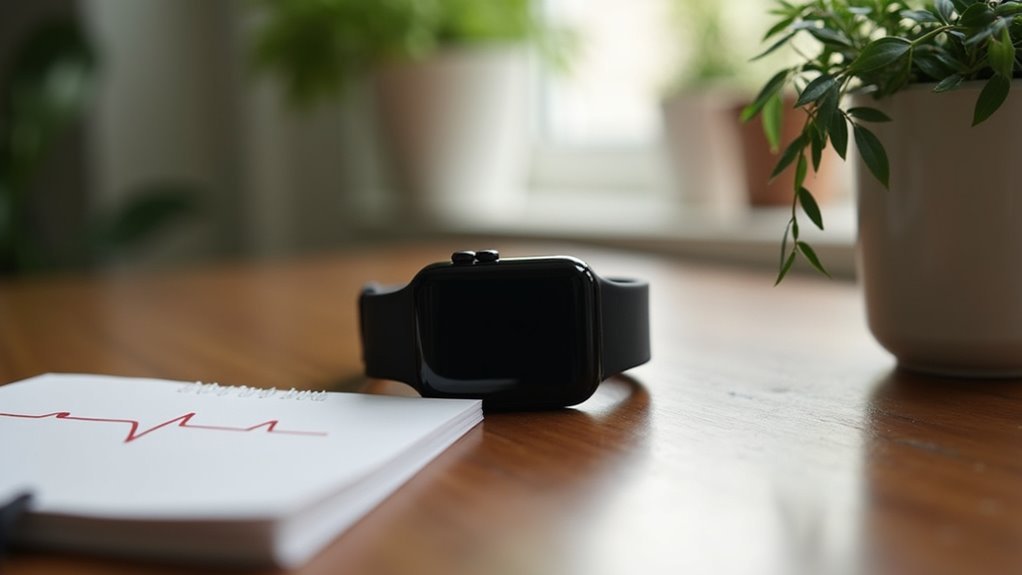
As your heart beats from moment to moment, the subtle variations in timing between each beat tell a sophisticated story about your stress levels. Your autonomic nervous system controls this beat-to-beat rhythm through opposing forces: sympathetic signals that speed up your heart during stress, and parasympathetic signals that slow it down during relaxation.
When you’re stressed, your sympathetic nervous system dominates, decreasing the variability between heartbeats. Conversely, when you’re relaxed, your parasympathetic system increases this variability.
Your fitness tracker captures these changes through photoplethysmography, measuring metrics like RMSSD and LF/HF ratios that reflect your autonomic balance. While chest strap monitors generally provide more accurate measurements, wrist-based devices offer convenient daily tracking of your HRV patterns.
This real-time window into your stress response helps you identify patterns and triggers, supporting early intervention before chronic stress impacts your cardiovascular and mental health.
Real-Time Health Monitoring for Stress Prevention
The power of heart rate variability monitoring extends beyond simple stress detection—modern fitness trackers now offer extensive real-time health monitoring systems that actively prevent stress from escalating into more serious health concerns.
Modern fitness trackers transform from simple step counters into sophisticated health guardians that intercept stress before it becomes dangerous.
Your device combines multiple physiological signals like electrodermal activity, heart rate, and temperature to create thorough stress profiles. When stress peaks, you’ll receive immediate alerts with personalized interventions—breathing exercises, mindfulness guidance, or physical activity recommendations tailored to your patterns.
This real-time approach transforms stress management from reactive to proactive. You’ll identify triggers before they overwhelm you, recognize recurring patterns, and develop targeted coping strategies.
Advanced algorithms analyze your data continuously, providing contextualized feedback about environmental factors affecting your stress levels, ultimately enabling timely intervention when you need it most. Higher HRV readings typically indicate positive health status, while consistently lower values may signal the need for immediate stress management intervention.
Performance Optimization Through Stress Pattern Recognition
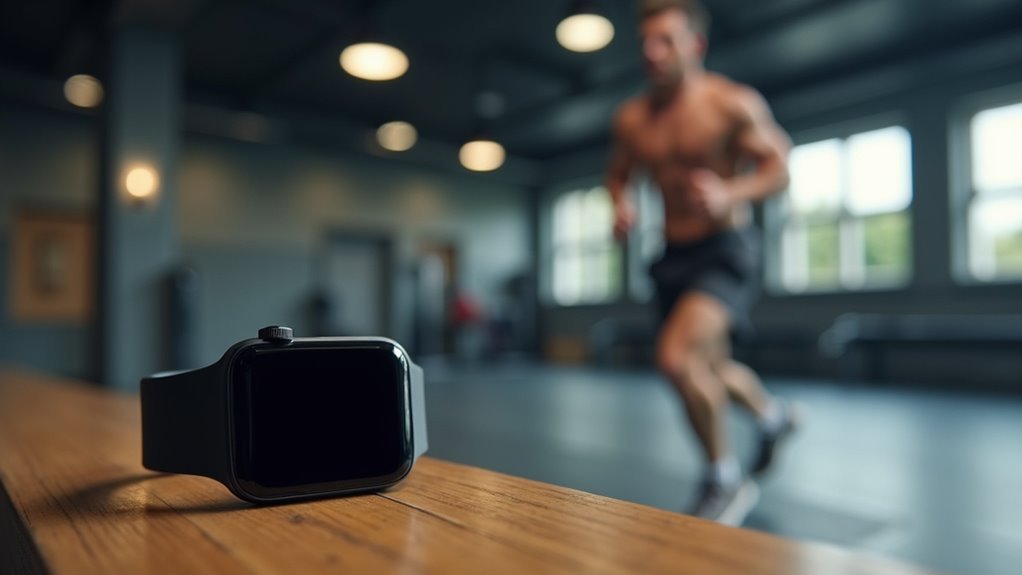
Understanding your unique stress patterns transforms how you can enhance performance across demanding situations. Your wearable device achieves 87% accuracy in classifying poor mental health and stress, while stress-specific patterns reach 78.3% accuracy through heart rate and HRV monitoring.
This continuous data collection creates dynamic stress response maps that reveal when you’re approaching performance decline.
You’ll benefit from multimodal sensors collecting accelerometer, gyroscope, and temperature data alongside movement patterns. Machine learning algorithms analyze these combined signals to detect your stress signatures before they impact performance.
In high-stress professions like healthcare and military work, these patterns guide ideal workload and recovery cycles. Early detection of stress accumulation helps you minimize errors and adjust rapidly to environmental demands. These measurable indicators serve as biomarkers that provide essential insights into your body’s stress response and overall physiological function.
Personalized Wellness Strategies Based on Biomarker Data
Your fitness tracker’s stress biomarker data becomes the foundation for creating wellness strategies that match your unique physiological patterns.
You’ll receive tailored stress management plans based on how your cortisol levels, heart rate variability, and other biomarkers respond to different situations throughout your day.
These adaptive recommendations evolve as your biomarker patterns change, ensuring your wellness approach stays aligned with your body’s current needs rather than following generic advice.
The integration of artificial intelligence enhances these personalized recommendations by analyzing your biomarker trends and predicting optimal intervention timing for maximum stress reduction effectiveness.
Tailored Stress Management Plans
When your fitness tracker detects elevated cortisol levels or irregular heart rate variability, it doesn’t just sound an alarm—it creates a personalized roadmap for bringing your stress back into balance.
These tailored plans emerge from analyzing your unique biomarker patterns, daily habits, and stress triggers. Unlike generic wellness advice, your tracker’s algorithms craft specific interventions based on your baseline readings and goals.
You’ll receive actionable recommendations that might include targeted breathing exercises when skin temperature spikes, adjusted workout intensity based on HRV fluctuations, or modified sleep schedules responding to cortisol rhythms.
As your biomarkers shift, your plan adapts dynamically. This personalized approach outperforms one-size-fits-all strategies because it addresses your individual stress signature, creating rapid feedback loops that help you understand which lifestyle adjustments actually work for your body. This continuous monitoring enables anticipatory medicine that can identify stress-related health risks before clinical symptoms develop.
Individual Biomarker Pattern Analysis
Behind these personalized stress management recommendations lies sophisticated pattern analysis that transforms your biomarker data into actionable insights.
Machine learning algorithms like k-means clustering process your standardized biomarker measurements to identify distinct response patterns unique to your physiology. This computational approach reveals how your body specifically reacts to stressors compared to others with similar profiles.
Your fitness tracker contributes continuous physiological data that enriches this analysis:
- Sleep stage patterns correlate with inflammatory marker fluctuations
- Heart rate variability trends reveal stress response timing
- Activity level changes link to muscle enzyme variations
- Recovery metrics align with metabolic indicator shifts
This integration creates dynamic biomarker clusters that evolve with your changing health status, enabling real-time adjustments to your wellness strategy based on emerging patterns. Advanced wearable technology enables precise tracking of sleep and activity patterns that enhance the accuracy of these personalized biomarker correlations.
Adaptive Wellness Recommendations
As your biomarker patterns become clearer through continuous analysis, your fitness tracker transforms this data into adaptive wellness recommendations tailored specifically to your physiological responses.
These personalized suggestions evolve based on your ongoing biomarker monitoring and lifestyle feedback, offering actionable guidance like guided breathing exercises or meditation when stress levels spike.
Your device creates feedback loops that inform you about physiological changes before you’re consciously aware, enabling timely interventions through automated alerts when biomarker values exceed recommended thresholds.
Integration with health apps allows cross-referencing of stress data with sleep, activity, and nutrition metrics, building extensive wellness profiles. Advanced platforms filter through marketing claims to deliver performance filtering that focuses specifically on biomarkers relevant to your active lifestyle and athletic goals.
Research demonstrates these data-driven interventions reduce depression symptoms by over 50% while improving life satisfaction by 24% through persistent, objective personalization.
Workplace Stress Management With Continuous Monitoring
You can transform your workplace’s approach to stress management by implementing fitness trackers that detect occupational stress in real-time through biomarker analysis.
These wearable devices help you identify early warning signs of employee burnout before they escalate into serious health issues or resignations. With 90% of employees reporting feeling stressed at work, early detection becomes critical for preventing widespread workplace dysfunction.
When you monitor stress patterns continuously, you’ll optimize your team’s performance under pressure while creating targeted interventions that protect both productivity and well-being.
Real-Time Occupational Stress Detection
While traditional stress management approaches often rely on periodic assessments or self-reporting, modern wearable devices revolutionize occupational stress monitoring by detecting stress biomarkers in real-time throughout your workday.
Your fitness tracker continuously analyzes physiological signals like heart rate variability (HRV) and electrodermal activity (EDA) using integrated machine learning algorithms. This proactive approach enables immediate interventions when stress levels spike, shifting from reactive to preventive wellness strategies. Unlike traditional 12-lead ECG systems that are immobile and require trained experts for interpretation, wearable devices provide continuous accessibility for ongoing stress assessment without limiting your mobility or daily activities.
Real-time occupational stress detection offers these key advantages:
- Immediate Response: You’ll receive instant alerts when stress biomarkers indicate elevated levels.
- Customized Feedback: Your device provides personalized stress management recommendations based on your unique patterns.
- Early Intervention: Continuous monitoring prevents chronic stress development through timely warnings.
- Enhanced Productivity: Managing stress effectively increases your job satisfaction and workplace performance.
Preventing Employee Burnout Early
Before burnout symptoms become visible to managers or even employees themselves, continuous stress monitoring through fitness trackers detects the subtle physiological shifts that signal impending workplace exhaustion. You’ll benefit from objective biomarker data that identifies stress precursors before performance deteriorates, enabling timely interventions when they’re most effective.
| Early Detection Benefits | Cost Impact | Intervention Outcomes |
|---|---|---|
| 90% of employees report workplace stress | $51B annual absenteeism costs | Reduced turnover rates |
| Physiological changes detected early | Lower healthcare expenses | Enhanced productivity |
| Objective measurement reduces bias | Better wellness ROI | Improved company reputation |
Your organization can leverage predictive analytics and machine learning to forecast burnout risk, creating customized support programs that address individual needs while maintaining thorough HR oversight. With 57% of workers experiencing negative impacts from work-related stress including emotional exhaustion and reduced productivity, early detection becomes crucial for maintaining workforce stability.
Performance Optimization Under Pressure
When stress levels spike during high-pressure work situations, continuous monitoring through fitness trackers enables you to maintain peak performance by providing real-time physiological feedback that guides immediate stress management decisions.
Your fitness tracker’s biomarker data creates personalized optimization strategies that adapt to your unique stress responses. Real-time feedback helps you self-regulate under pressure, maintaining cognitive performance during demanding periods. Unlike workplace monitoring systems where 56% of monitored employees report feeling tense or stressed, personal fitness trackers empower you to take control of your own stress management.
Machine learning algorithms analyze your EDA and HRV patterns, delivering actionable insights for performance sustainability.
Here’s how continuous monitoring optimizes your workplace performance:
- Personalized stress management programs tailored to your individual physiological responses
- Identification of specific stress triggers enabling optimized task allocation and break scheduling
- Longitudinal trend analysis supporting preventive strategies before stress becomes debilitating
- Proactive coping strategy development enhancing resilience during high-demand work environments
Advanced Algorithms That Transform Raw Data Into Actionable Insights
As your fitness tracker collects streams of physiological data throughout the day, sophisticated algorithms work behind the scenes to transform these raw signals into meaningful stress insights you can actually use.
The process begins with feature extraction, where statistical, spectral, and time-domain metrics are computed from your heart rate variability, skin temperature, and accelerometer data.
Machine learning models then analyze these features using supervised learning techniques, trained on labeled stress episodes to classify your current state.
Real-time processing enables immediate detection of stress onset, triggering personalized alerts and recommendations. Advanced systems like the Stress-Track achieve remarkable 99.5% accuracy in stress level classification through ensemble methods.
These algorithms continuously adapt to your individual physiological baseline, dynamically adjusting prediction thresholds to provide accurate stress scores, visualizations, and actionable coping strategies tailored specifically to your needs.
Frequently Asked Questions
How Long Does the Battery Last When Continuously Monitoring Stress Biomarkers?
Your battery life varies considerably by device when continuously monitoring stress biomarkers. You’ll get 2 days with Empatica E4, 5 days with NOWATCH, 8 days with Oura Ring, and 11 days with Garmin vívoactive 5.
Are Stress Readings Affected by Medications or Medical Conditions?
Yes, your stress readings can be greatly affected by medications and medical conditions. Beta-blockers, stimulants, antidepressants, and conditions like cardiovascular disease or endocrine disorders will alter your device’s biomarker measurements.
Can Fitness Trackers Distinguish Between Physical Exertion and Emotional Stress?
You’ll find that fitness trackers struggle to distinguish between physical exertion and emotional stress since both create similar physiological responses like increased heart rate and elevated skin temperature, requiring advanced algorithms.
What Happens to My Stress Data if I Switch Devices?
When you switch devices within the same brand’s ecosystem, your stress data transfers seamlessly through cloud sync. However, switching between different brands typically results in losing historical stress data unless you manually export it first.
Do Stress Monitoring Features Work Accurately for All Age Groups?
Stress monitoring features don’t work equally well across all ages. You’ll find they’re most accurate for healthy adults, but accuracy diminishes for children and elderly due to different physiological patterns and biomarker profiles.

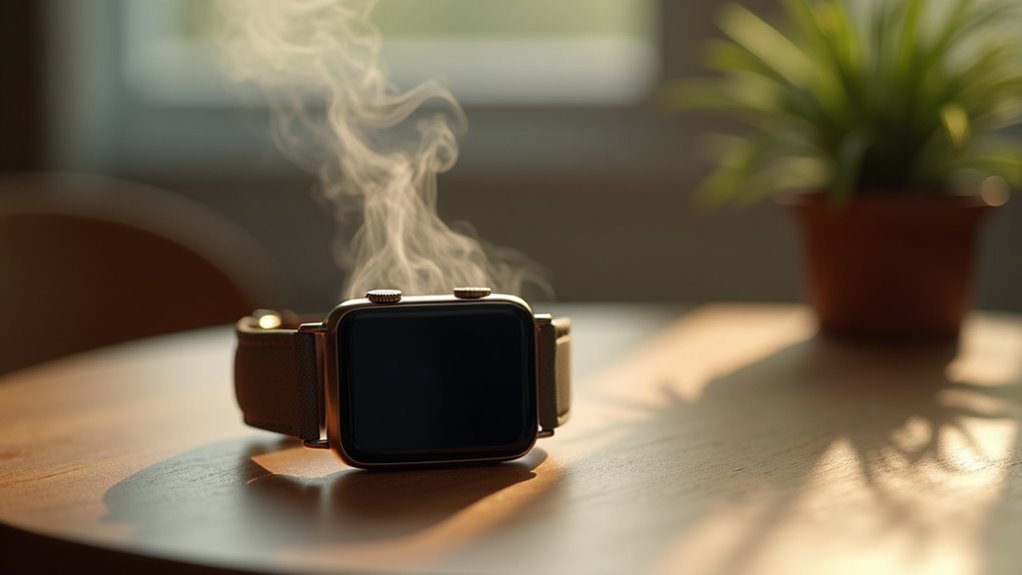
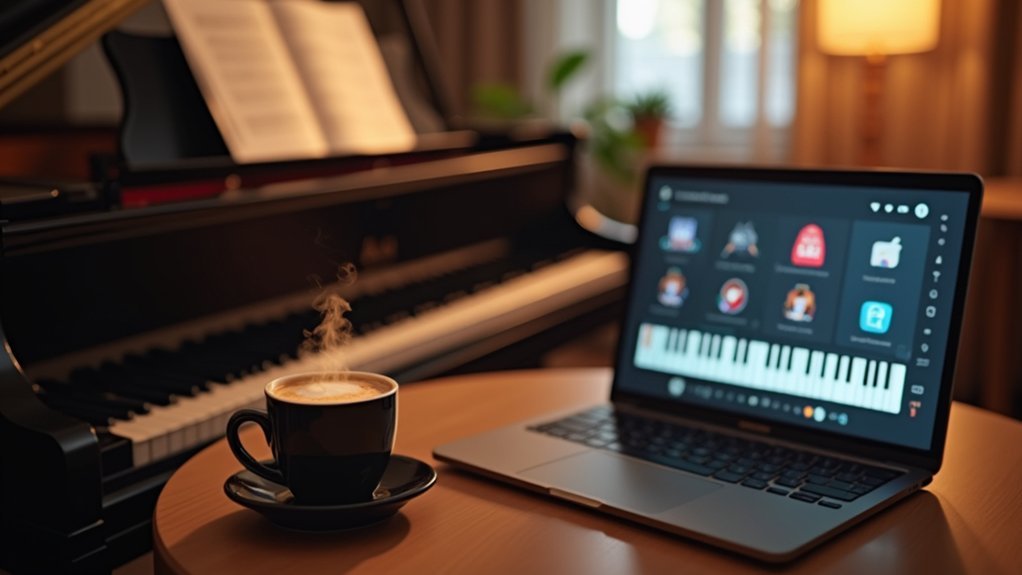
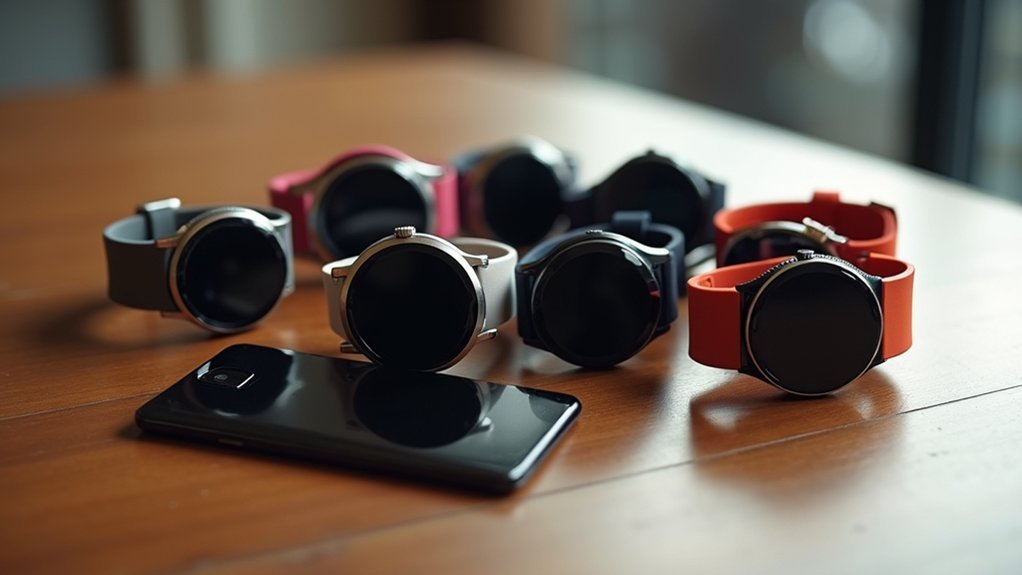
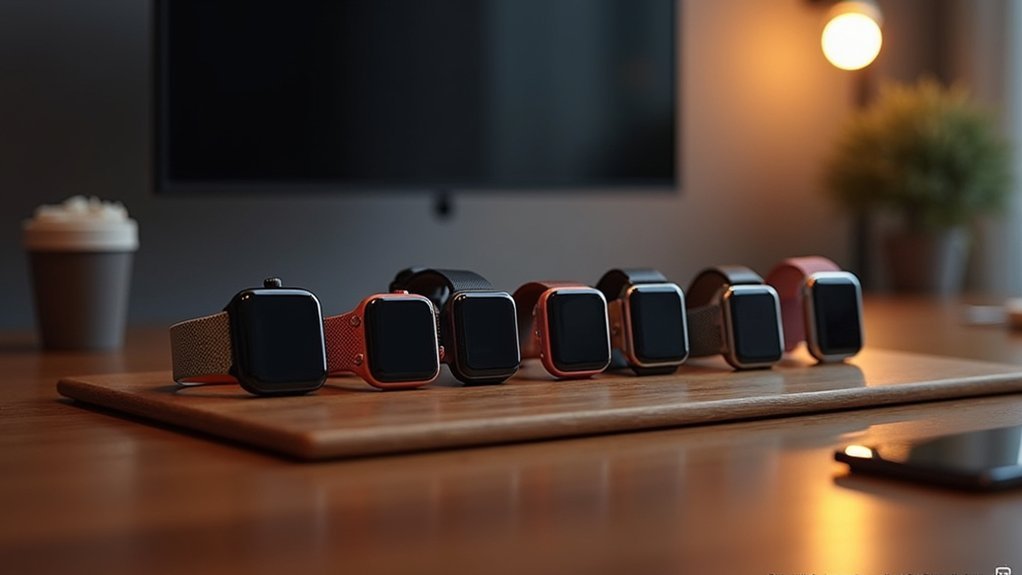
Leave a Reply